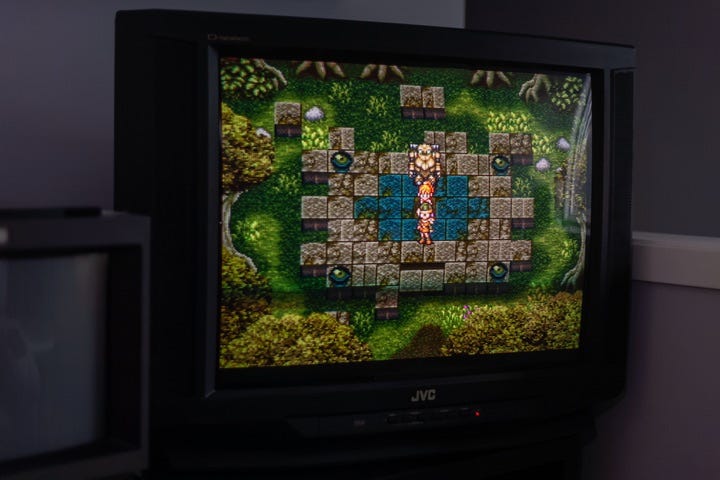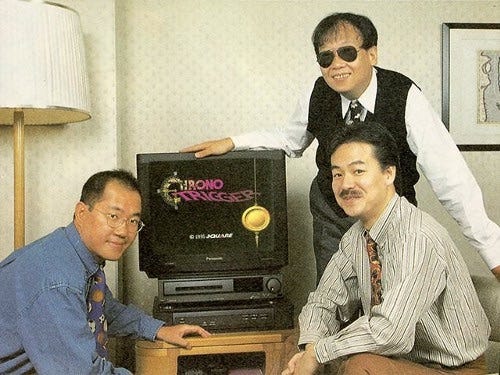Replay Value: Chrono Trigger — Party like it's 1999 (Part 1)
Exploring the apocalypse from the Millennial Fair to the depths of Magus's Castle
Welcome to Replay Value! In collaboration with Daniel Dockery, this four part miniseries will explore one of the most consequential games I covered in my book, Fight, Magic, Items: The History of Final Fantasy, Dragon Quest, and the Rise of Japanese RPGs in the West: Chrono Trigger!
Replay Value is a cross-newsletter series hosted by Daniel and myself where we’re each replaying a childhood favourite—Chrono Trigger and Pokemon Yellow, respectively—and asking each other pointed questions along the way. For the next four Fridays, you’ll track our progress in the game and get an inside track on just why we love these games so much. Head on over to Daniel’s terrific newsletter, , to check out his progress on Pokemon Yellow for the Game Boy. And consider checking out his amazing book, Monster Kids: How Pokémon Taught a Generation to Catch Them All, which is a great companion to Fight, Magic, Items.
- Replay Value: Chrono Trigger — Party Like It's 1999
- Replay Value: Chrono Trigger — The Writer on Mt. Woe
- Replay Value: Chrono Trigger — A wild side quest appears!
- Replay Value: Chrono Trigger — *coming December 1*
Hope you brought your Gate Key!

In this kickoff instalment of Replay Value, I’ve played from Chrono Trigger’s opening to the end of Magus’s Castle. This constitutes the game’s first act—and crescendos from the low stakes disappearance of Marle at the Millennial Fair to the explosive encounter with the dark mage as he tries to summon Lavos. As Daniel alludes to in his questions below, I regularly replay Chrono Trigger and know the game inside-and-out, but this early portion always pulls me back in thanks to its incredible pacing. There’s always something new—a dungeon, big boss, plot beat, twist, new era, etc.—happening every ten minutes—there’s just never a good time to put the controller down.
I also love how the game opens with a very obvious “bad guy” and follows a traditional epic fantasy arc of trying to take down the dark mage—only for things to go extremely awry when they finally defeat Magus, and… well, that’s for next issue.
Q&A with Daniel Dockery
Daniel Dockery: So, I imagine Chrono Trigger is pretty indefinitely replayable for you. What sets you in that Chrono Trigger mood? What makes you think "Okay, it's time to play Chrono Trigger again?"
Aidan Moher: I mean, at this point in my life, I’ve played through Chrono Trigger so many times that it’s become this sort of seminal aspect of my relaxation time, right? What makes someone think “Okay, it’s time to listen to my favourite album again?” Obviously, playing a JRPG is more of a time commitment than popping on Less Than Jake’s “Borders and Boundaries” while I’m driving around running errands, but thanks to its New Game + feature—not the first in gaming, but the first to popularize the idea—it is easy to play through the game in daily 30 minute chunks over the course of the month.
It’s comfort food, a safe place for retreat, a source of inspiration, a familiar adventure, a palate cleanser. Any time I need one of those things, I’ll go find Chrono Trigger. And then, of course, professionally, I write about it a lot, so whether it’s for a newsletter series like this, or my big history of its creation and legacy, I often find myself replaying chunks or the whole game as a refresher on just why it’s the best game of all time.
DD: The character designs are lauded for a reason - it's Akira Toriyama. The dude can't not make a memorable design. What makes Toriyama's work so everlasting across multiple mediums?
AM: Chrono Trigger is really interesting because it initially started life—along with Secret of Mana—as a project called Maru Island, which was conceived specifically to highlight Toriyama’s art on Nintendo’s upcoming CD-ROM add-on, the Nintendo PlayStation. When that went under, Nintendo decided to postpone the Toriyama project and made Secret of Mana, instead (which is famous for all its cut content due to the CD-ROM projec crumbling). This is almost certainly why Secret of Mana’s Randi and Primm look very similar to Chrono Trigger’s Crono and Marle.
Ever notice how Secret of Mana’s Randi and Primm look similar to Chrono Trigger’s Crono and Marle? Well, perhaps it’s not such a coincidence—both games share an origin in a Nintendo PlayStaion project called The Secret of Maru Island.
— Aidan Moher (Not Parody) (@adribbleofink) 4:13 PM ∙ Oct 25, 2022
Eventually, the spirit of the ideal materialized as Yuji Horii and Akira Toriyama, who traditionally worked with Enix on the Dragon Quest series, joined Final Fantasy creator Hironobu Sakaguchi on Chrono Trigger. Toriyama has been involved with Japanese RPGs since the genre’s inception with the first Dragon Quest on NES, but the immaturity of the technology and the genre meant his unique style was only really noticeable in the series’s incredible concept art and enemy designs in combat. By the end of the Super NES’s lifespan, though, graphics had advanced to a place where Chrono Trigger’s environments and characters felt like Akira Toriyama concept art come to life. It’s not a coincidence that Japanese RPGs started taking off in the west right around the same time Japanese RPGs were taking off, and there was something pretty special in seeing Dragon Ball Z full of characters that looked like they could’ve come out of my favourite game and vice versa.
Toriyama’s brilliant in the way he uses simplicity to help highlight his characters with singular memorable attributes. Goku’s hair. Krillin’s height. Robo’s soft, rounded features making him feel more human. Magus’s melancholy. They don’t drown in details, so his designs transition beautifully to video games—especially in a genre known for its over-designed characters.

DD: Gato's theme music is one of my favorite little bits of all time. What's your favorite piece in Chrono Trigger?
AM: Oh, man. You’re really going to make me decide? Considering Chrono Trigger was legendary composer Yasunori Mitsuda’s first full video game score, the depth is incredible—and still pales compared to his series follow-up, Chrono Cross. Chrono Trigger does upbeat, high-tempo anthems well, including bouyant tunes like the Millennial Fair theme, and instantly memorable character themes (who can’t whistle Frog’s iconic theme from memory?), and it also does sad and serious with exceptional maturity. The reason I love Mitsuda so much is his ability to pull influences from many sources—he’s never content with just one sound, but it all feels like it’s of a greater whole. Pretty remarkable.
But, the best song in the game? Probably also its simplest: “Far Off Promise.”
DD: A time hopping storyline sounds like it might get kind of confusing, but Chrono Trigger's is very approachable. Why is that?
AM: The number one biggest thing it gets right is that it doesn’t try to get it “right.” Chrono Trigger’s not concerned with time paradoxes (except for the game’s first quest to save Marle, but it’s never brought up again), the timeline moves along concurrently in each time period, rather than the player being able to warp to fixed points in time, resetting progress, etc. and the cause-and-effect nature of the story is predetermined and not actually as non-linear or choice-based as the game wants you to believe.
If everyone does every side quest, they’ll get the exact same ending outside of a few differences (Is the Epoch intact? How many cats you got? That sort of stuff.) Many time travel games drown in player choice, or try to create complex butterfly-effect story lines, but Chrono Trigger avoids all that, focusing instead on a surprisingly linear main plot, and providing player choice in the game’s back-half that gives the illusion of agency, without any of the risk.
So, I think the approachability comes from its clever execution of making the player feel like they’ve got choice, but not giving them much choice at all outside of superficial non-linearity and a couple of non-consequential irreversible choices like taking the Safe Helm or the Swallow, and how to approach the final battle with Lavos, which can slightly tweak the ending.
End Step
Feel free to leave a comment before with your own answers to Daniel’s questions, or join the Replay Value conversation on the Substack app!
And, subscribe to make sure you get the next instalment of Replay Value: Chrono Trigger in your inbox next Friday!
Support
There are lots of ways to support Astrolabe and my other work. Check ‘em out!
Keep In Touch
Enjoy Astrolabe? Want more SFF and retro gaming goodies? You can find me on Twitter and my website.
Credits
Astrolabe banner photo by Shot by Cerqueira on Unsplash

